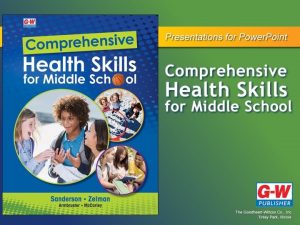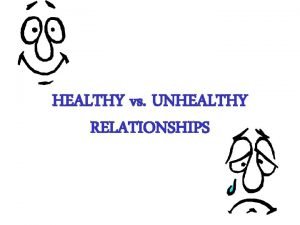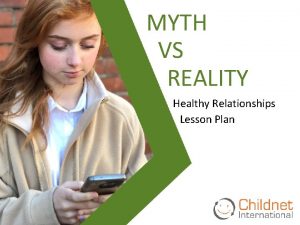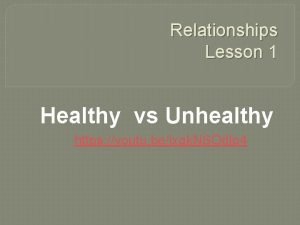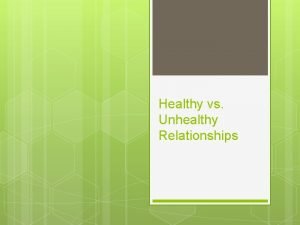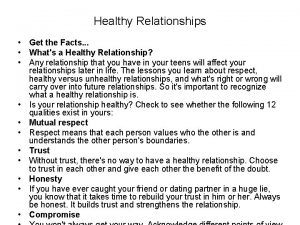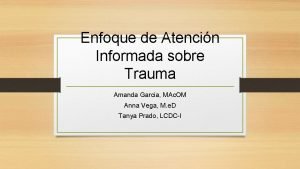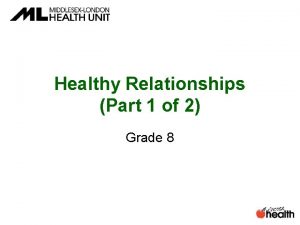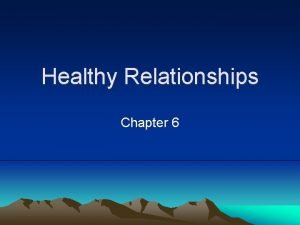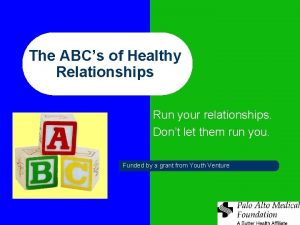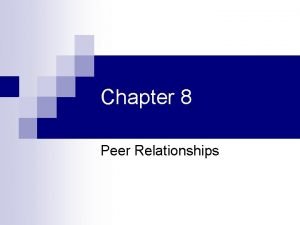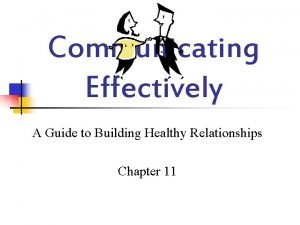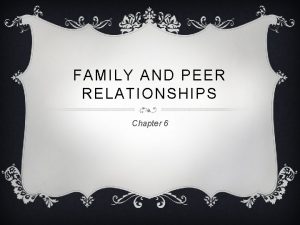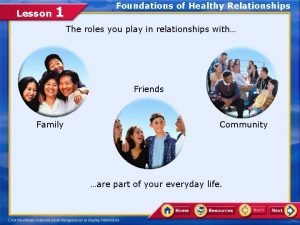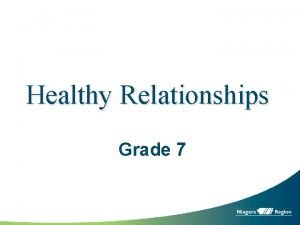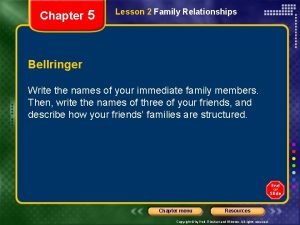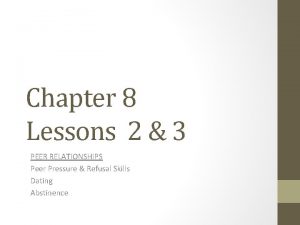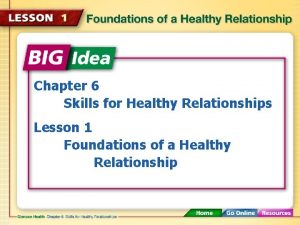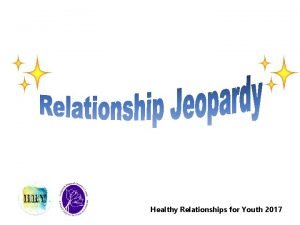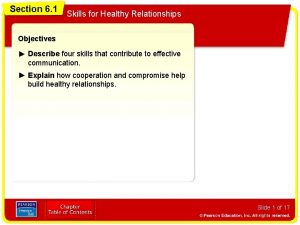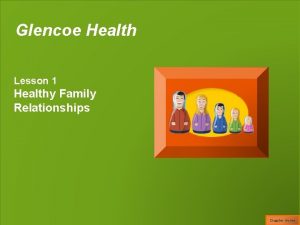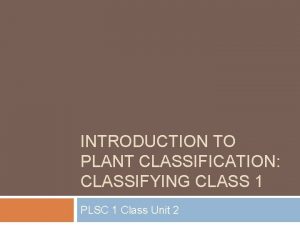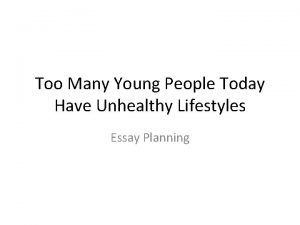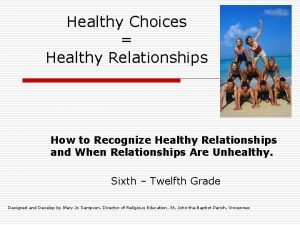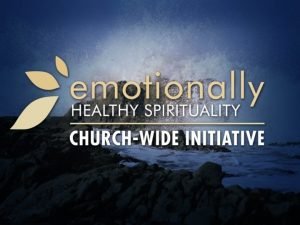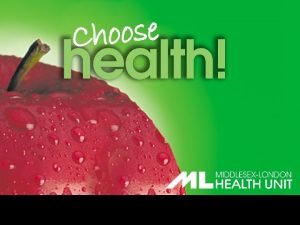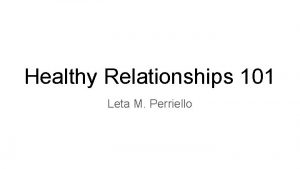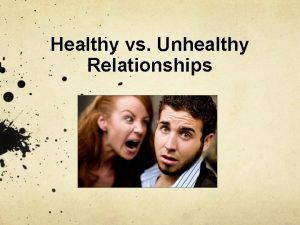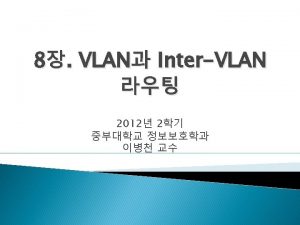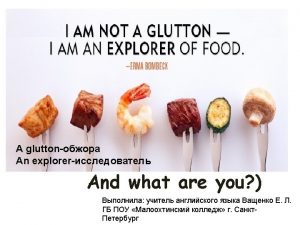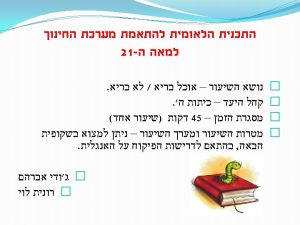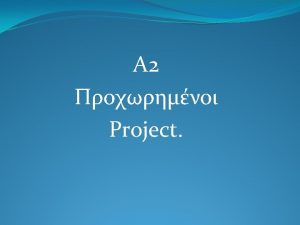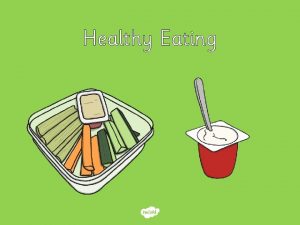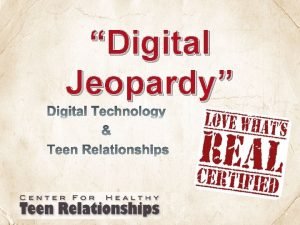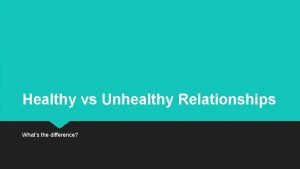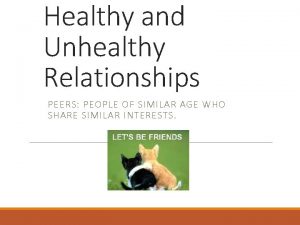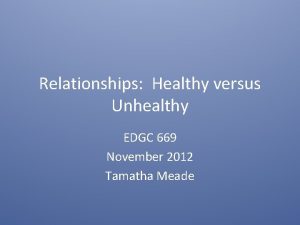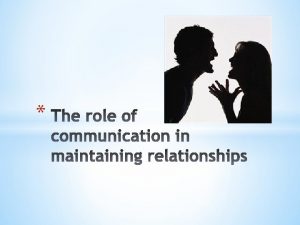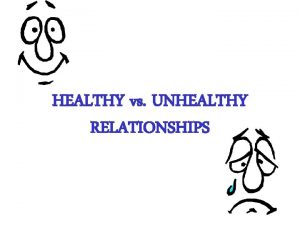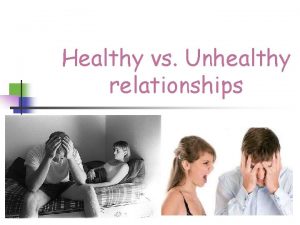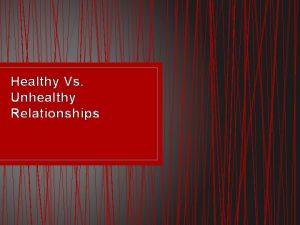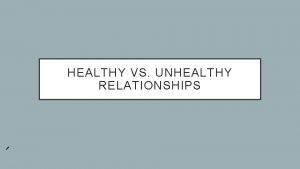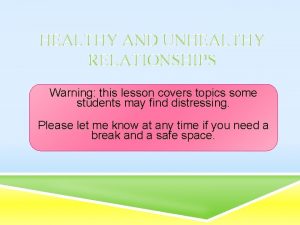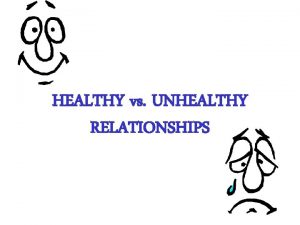Unhealthy Vs Healthy Relationships Amanda Garcia MAc OM







































- Slides: 39

Unhealthy Vs. Healthy Relationships Amanda Garcia, MAc. OM Tanya Prado, LCDC-I Anna Vega, M. Ed

Disclaimer • Talking or reading about trauma and certain topics can be difficult and may cause strong feelings and reactions. Please take care and be mindful as you participate in this training. • This presentation is for educational purposes only and should not be construed as professional mental health advice or any mental health diagnosis, nor is the information a substitute for professional medical advice.

Objectives • • • Identify the differences between toxic vs. healthy relationships Identify the Types of Relationships Understand the 3 different types of abuse Recognize and identify how violence affects children The Power Wheel The Equality Wheel


Family Friends Types of Relationshi ps Romantic Casual • Professional • Acquaintances

3 Types of Abuse • Verbal/Emotional: • Physical: • Sexual:


Characteristics of an Unhealthy Relationship • • • Manipulation Controlling Criticizing Intimidation Unhappy in the relationship Threatening or mistreating

Signs of an Abusive Relationship • • Jealousy Controlling behavior Quickly “fall in love” Isolation Drug or alcohol abuse Blame others Get angry easily • • • Cruelty to animals Extreme mood swings Past batterer Destroys property Threaten to hurt their partner or self

What are the effects of violence on children? • • RUNAWAY TRUANCY INJURIES LIKELY TO CONTINUE THE CYCLE OF VIOLENCE • VIOLENCE AT SCHOOL

Healthy Relationships • Willingness to communicate without blame • Knows when to talk things out and when to wait until a better time • Physical touch and affection is mutually enjoyable • Able to express anger without blame or making the other person wrong • Aware of when its time to seek outside help • Respect different opinions

The Three R’s In Healthy Relationships Rights Respect Responsibility

Rights • • • I have the right not to be abused. I have the right to develop my talents. I have the right to privacy. I have the right to express my own thoughts and feelings. I have the right to develop and have friendships. I have the right not to be perfect.

Respect • Respect is to feel or show honor or esteem for. • Respect is to value as an equal. • Respect is to show considerations for.

Responsibility • I am responsible for what I think, feel, and do. • I am responsible for my health and safety. • I am responsible to develop and communicate my personal boundaries. • I am NOT responsible for what others think, feel and do.

Everyone is part of relationships Importance of Healthy Relationshi ps Being in a healthy relationship helps us: • • Know ourselves Develop as a person Grow emotionally Communicate and maintain meaningful bonds with other people • Have fun!

How to Maintain a Healthy Relationship • The ingredients are simple: • • • Appreciate each other’s qualities Have good communication Keep realistic expectations Have shared interests The ability to face and deal with conflicts together Value yourself and the other person

Tools for solving a conflict • Mediation- objective third party helps • Negotiation- mutual discussion and arrangement • Compromise- a settle of differences by mutual concessions (meet in the middle) • Empathy- seeing things from another person's perspective

Power and Control Wheel • The outer wheel: Physical and Sexual Violenceinstills fear, continuum

• Putting down the other person • Making the other person feel bad about themselves EMOTIONAL AND VERBAL ABUSE • Name-calling • Playing Mind Games • Humiliation • Causing Guilt

• Controlling the other persons behaviors ISOLATION • Limiting outsides involvement • Using jealousy to justify actions

• Making light of the abuse and not taking the other persons concerns seriously MINIMIZING, DENYING, AND BLAMING • Saying that the abuse did not happen • Shifting responsibility for abusive behavior • Saying that the other person caused it

• Making the partner feel guilty about the children • Using children to relay USING CHILDREN messages • Using visitation as a form of harassment • Threating to take the children away from a parent

• Preventing someone from getting or keeping a job • Making somebody in the ECONOMIC ABUSE relationship ask for money • Giving somebody an allowance • Taking somebody’s money • Hiding family income

• Treating the other like a USING PRIVILEGE servant, making all the decisions, acting like the “master of the castle”, being the one to define men’s and women’s roles

• Making and/or carrying out harmful threats • Threatening to leave, commit COERCION AND THREATS suicide, or report somebody to welfare • Making somebody drop charges • Making somebody do illegal things

• Making somebody afraid by using looks, actions, and gestures. INTIMIDATION • Smashing things. • Destroying property. • Abusing pets. • Displaying weapons.

Equality wheel Qualities involved in healthy relationships. Non-violent partnerships

NONTHREATENING BEHAVIOR • Talking and acting so that the other person feels safe and comfortable expressing themselves and doing things

• Listening to the other person non-judgmentally RESPECT • Being emotionally affirming and understanding • Valuing opinions

• Supporting the other TRUST AND SUPPORT persons goals in life • Respecting their right to their own feelings, friends, activities and opinions

• Accepting responsibility for yourself • Acknowledging past use of HONESTY AND ACCOUNTABILITY violence • Admitting being wrong • Communicating openly and truthfully

• Sharing parental RESPONSIBL E PARENTING responsibilities • Being a positive non-violent role model for the children

• Mutually agreeing on a fair SHARED RESPONSBILITY distribution of work • Making family decisions together

• Making money decisions ECONOMIC PARTNERSHI P together • Making sure both partners benefit from financial arrangements

• Seeking mutually satisfying NEGOTIATION AND FAIRNESS resolutions to conflict • Accepting change • Being willing to compromise

What can you do if someone you know is being abused?

Short film • Removed Film

If you or someone you know is a victim of domestic violence or someone having problems with substance abuse and needs • Wellness Counselor • Anna Vega: Buckner Campus 512 -688 -0161, vegaannac@gmail. com • There is help in the community: • Mujeres Unidas: Domestic Violence Services 1 -800 -580 -4879 Brochure: Spanish Mujeres Unidas English • Tropical Texas Behavioral Health: 1 -877 -289 -7199 • Behavioral Health Solutions of South Texas: 956 -787 -7111 ext. 225 • National Domestic Violence Hotline 1 -800 -799 -7233
 Chapter 18 healthy family and peer relationships
Chapter 18 healthy family and peer relationships Healthy unhealthy relationship scenarios
Healthy unhealthy relationship scenarios Healthy relationships lesson plan
Healthy relationships lesson plan Healthy vs unhealthy relationships worksheet
Healthy vs unhealthy relationships worksheet Scenarios of unhealthy relationships
Scenarios of unhealthy relationships Healthy vs unhealthy dating relationships
Healthy vs unhealthy dating relationships Facts about a healthy relationship
Facts about a healthy relationship Military power and control wheel
Military power and control wheel Healthy vs unhealthy weight loss
Healthy vs unhealthy weight loss Amanda garcia compañeros
Amanda garcia compañeros Mac bethad mac findláich
Mac bethad mac findláich Mac mac o kok dac
Mac mac o kok dac Healthy nurse healthy nation
Healthy nurse healthy nation Healthy forests healthy communities poster ideas
Healthy forests healthy communities poster ideas Journal on healthy food healthy mind
Journal on healthy food healthy mind Healthy soil healthy life poster ideas
Healthy soil healthy life poster ideas Healthy relationships
Healthy relationships Chapter 6 skills for healthy relationships
Chapter 6 skills for healthy relationships Abc's of healthy relationships
Abc's of healthy relationships Chapter 8 lesson 1 safe and healthy friendships
Chapter 8 lesson 1 safe and healthy friendships Healthy relationships communicating effectively
Healthy relationships communicating effectively Acquaintance vs friend
Acquaintance vs friend Chapter 6 lesson 1 foundations of a healthy relationship
Chapter 6 lesson 1 foundations of a healthy relationship Relationship jeopardy
Relationship jeopardy Healthy relationships
Healthy relationships Chapter 5 family relationships answers
Chapter 5 family relationships answers Chapter 8 lesson 1 safe and healthy friendships
Chapter 8 lesson 1 safe and healthy friendships Chapter 7 family relationships
Chapter 7 family relationships Chapter 6 skills for healthy relationships lesson 1
Chapter 6 skills for healthy relationships lesson 1 Healthy relationships jeopardy
Healthy relationships jeopardy Healthy peer relationships
Healthy peer relationships Healthy relationships vocabulary
Healthy relationships vocabulary Chapter 7 family relationships
Chapter 7 family relationships Healthy christian boundaries
Healthy christian boundaries Glencoe health chapter 7
Glencoe health chapter 7 Dead plant roots
Dead plant roots Teenager unhealthy lifestyle essay
Teenager unhealthy lifestyle essay Unhealthy communication
Unhealthy communication The problem of emotionally unhealthy spirituality
The problem of emotionally unhealthy spirituality Unhealthy symbiotic relationship
Unhealthy symbiotic relationship
